氯化铵MSDS
- 格式:doc
- 大小:49.00 KB
- 文档页数:4
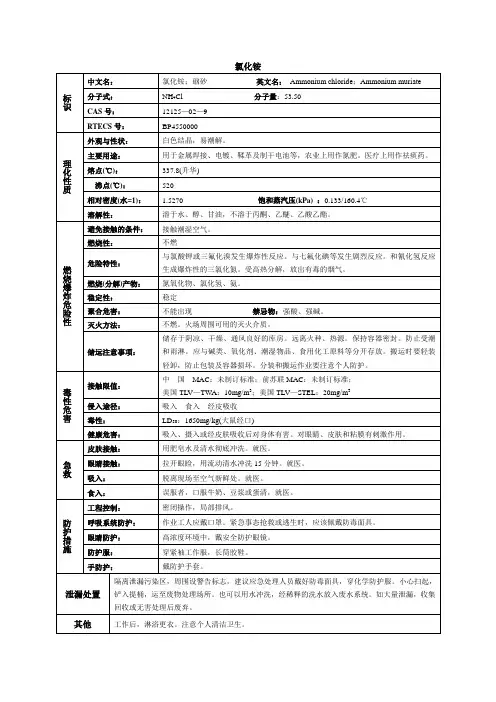
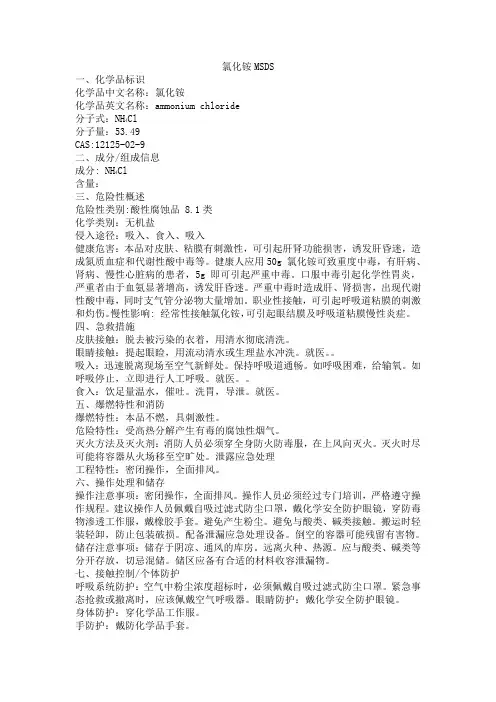
氯化铵MSDS一、化学品标识化学品中文名称:氯化铵化学品英文名称:ammonium chlorideCl分子式:NH4分子量:53.49CAS:12125-02-9二、成分/组成信息Cl成分: NH4含量:三、危险性概述危险性类别:酸性腐蚀品 8.1类化学类别:无机盐侵入途径:吸入、食入、吸入健康危害:本品对皮肤、粘膜有刺激性,可引起肝肾功能损害,诱发肝昏迷,造成氮质血症和代谢性酸中毒等。
健康人应用50g 氯化铵可致重度中毒,有肝病、肾病、慢性心脏病的患者,5g即可引起严重中毒。
口服中毒引起化学性胃炎,严重者由于血氨显著增高,诱发肝昏迷。
严重中毒时造成肝、肾损害,出现代谢性酸中毒,同时支气管分泌物大量增加。
职业性接触,可引起呼吸道粘膜的刺激和灼伤。
慢性影响: 经常性接触氯化铵,可引起眼结膜及呼吸道粘膜慢性炎症。
四、急救措施皮肤接触:脱去被污染的衣着,用清水彻底清洗。
眼睛接触:提起眼睑,用流动清水或生理盐水冲洗。
就医。
吸入:迅速脱离现场至空气新鲜处。
保持呼吸道通畅。
如呼吸困难,给输氧。
如呼吸停止,立即进行人工呼吸。
就医。
食入:饮足量温水,催吐。
洗胃,导泄。
就医。
五、爆燃特性和消防爆燃特性:本品不燃,具刺激性。
危险特性:受高热分解产生有毒的腐蚀性烟气。
灭火方法及灭火剂:消防人员必须穿全身防火防毒服,在上风向灭火。
灭火时尽可能将容器从火场移至空旷处。
泄露应急处理工程特性:密闭操作,全面排风。
六、操作处理和储存操作注意事项:密闭操作,全面排风。
操作人员必须经过专门培训,严格遵守操作规程。
建议操作人员佩戴自吸过滤式防尘口罩,戴化学安全防护眼镜,穿防毒物渗透工作服,戴橡胶手套。
避免产生粉尘。
避免与酸类、碱类接触。
搬运时轻装轻卸,防止包装破损。
配备泄漏应急处理设备。
倒空的容器可能残留有害物。
储存注意事项:储存于阴凉、通风的库房。
远离火种、热源。
应与酸类、碱类等分开存放,切忌混储。
储区应备有合适的材料收容泄漏物。

AMMONIUM CHLORIDE MSDS1. Product IdentificationSynonyms: Sal ammoniac; Ammonium muriateCAS No.: 12125-02-9Molecular Weight: 53.49Chemical Formula: NH4ClProduct Codes:DAIXI : 0660Mallinckrodt: 1614, 3355, 3363, 3364, 33842. Composition/Information on IngredientsIngredient CAS No Percent Hazardous--------------------------------------- ------------ ------------ ---------Ammonium Chloride 12125-02-9 99 - 100% NO3. Hazards IdentificationEmergency Overview--------------------------WARNING! CAUSES IRRITATION TO SKIN, EYES AND RESPIRATORY TRACT. HARMFUL IF SWALLOWED OR INHALED.SAF-T-DATA(tm) Ratings (Provided here for your convenience)-------------------------------------------------------------------------------------------- Health Rating: 2 - ModerateFlammability Rating: 0 - NoneReactivity Rating: 2 - ModerateContact Rating: 2 - ModerateLab Protective Equip: GOGGLES & SHIELD; LAB COAT & APRON; VENT HOOD; PROPER GLOVESStorage Color Code: Green (General Storage)------------------------------------------------------------------------------------------- Potential Health Effects----------------------------------Inhalation:Causes irritation to the respiratory tract. Symptoms may include coughing, shortness of breath.Ingestion:Causes irritation to the gastrointestinal tract. Symptoms may include nausea, vomiting and diarrhea.Skin Contact:Causes irritation to skin. Symptoms include redness, itching, and pain.Eye Contact:Causes irritation, redness, and pain.Chronic Exposure:No information found.Aggravation of Pre-existing Conditions:No information found.4. First Aid MeasuresInhalation:Remove to fresh air. If not breathing, give artificial respiration. If breathing is difficult, give oxygen. Get medical attention.Ingestion:Induce vomiting immediately as directed by medical personnel. Never give anything by mouth to an unconscious person. Get medical attention.Skin Contact:Immediately flush skin with plenty of water for at least 15 minutes. Remove contaminated clothing and shoes. Get medical attention. Wash clothing before reuse. Thoroughly clean shoes before reuse.Eye Contact:Immediately flush eyes with plenty of water for at least 15 minutes, lifting upper and lower eyelids occasionally. Get medical attention.5. Fire Fighting MeasuresFire:Not considered to be a fire hazard.At fire temperatures ammonium chloride begins to corrode metals and may dissociate into ammonia and hydrogen chloride. Mixtures of about 16% to 25% (by volume) ammonia gas in air are flammable.Explosion:Not considered to be an explosion hazard.Fire Extinguishing Media:Use any means suitable for extinguishing surrounding fire. Water spray may beused to keep fire exposed containers cool.Special Information:In the event of a fire, wear full protective clothing and NIOSH-approvedself-contained breathing apparatus with full facepiece operated in the pressure demand or other positive pressure mode.6. Accidental Release MeasuresVentilate area of leak or spill. Wear appropriate personal protective equipment as specified in Section 8. Spills: Sweep up and containerize for reclamation or disposal. Vacuuming or wet sweeping may be used to avoid dust dispersal. US Regulations (CERCLA) require reporting spills and releases to soil, water and air in excess of reportable quantities. The toll free number for the US Coast Guard National Response Center is (800) 424-8802.7. Handling and StorageKeep in a tightly closed container. Protect from physical damage. Store in a cool, dry, ventilated area away from sources of heat, moisture and incompatibilities. Containers of this material may be hazardous when empty since they retain product residues (dust, solids); observe all warnings and precautions listed for the product.8. Exposure Controls/Personal ProtectionAirborne Exposure Limits:Ammonium chloride:-ACGIH Threshold Limit Value (TLV):10 mg/m3 (TWA); 20 mg/m3 (STEL) FumeVentilation System:A system of local and/or general exhaust is recommended to keep employee exposures below the Airborne Exposure Limits. Local exhaust ventilation is generally preferred because it can control the emissions of the contaminant at its source, preventing dispersion of it into the general work area. Please refer to the ACGIH document, Industrial Ventilation, A Manual of Recommended Practices, most recent edition, for details.Personal Respirators (NIOSH Approved):If the exposure limit is exceeded and engineering controls are not feasible, a half facepiece particulate respirator (NIOSH type N95 or better filters) may be worn for up to ten times the exposure limit or the maximum use concentration specified by the appropriate regulatory agency or respirator supplier, whichever is lowest.. A full-face piece particulate respirator (NIOSH type N100 filters) may be worn up to 50 times the exposure limit, or the maximum use concentration specified by the appropriate regulatory agency, or respirator supplier, whichever is lowest. If oil particles (e.g. lubricants, cutting fluids, glycerine, etc.) are present, use a NIOSH type R or P filter. For emergencies or instances where the exposure levels are not known, use a full-facepiecepositive-pressure, air-supplied respirator. WARNING: Air-purifying respirators do not protect workers in oxygen-deficient atmospheres.Skin Protection:Wear impervious protective clothing, including boots, gloves, lab coat, apron or coveralls, as appropriate, to prevent skin contact.Eye Protection:Use chemical safety goggles and/or full face shield where dusting or splashing of solutions is possible. Maintain eye wash fountain and quick-drench facilities in work area.9. Physical and Chemical PropertiesAppearance: White powder.Odor: Odorless.Solubility: 29.7g/100g water @ 0C (32F)Specific Gravity: 1.53pH: 5.5 (1% aq.sol.); 5.1 (3% aq.sol.); 5.0 (10% aq.sol.)% Volatiles by volume @ 21C (70F): 0Boiling Point: 520C (968F)Melting Point: 338C (640F) Sublimes.Vapor Density (Air=1): 1.9Vapor Pressure (mm Hg): 1.0 @ 160C (320F)Evaporation Rate (BuAc=1): No information found.10. Stability and ReactivityStability:Stable under ordinary conditions of use and storage.Hazardous Decomposition Products:Involvement in a fire causes decomposition to form hydrogen chloride and ammonia.Hazardous Polymerization:Will not occur.Incompatibilities:Concentrated acids, strong bases, silver salts, potassium chlorate, ammonium nitrate, bromine trifluoride and iodine heptafluoride. Ammonium chloride reacts explosively with potassium chlorate or bromine trifluoride, and violently with bromide pentafluoride, ammonium compounds, nitrates, and iodine heptafluoride. Explosive nitrogen trichloride may result from reaction of ammonium chloride and hydrogen cyanide.Conditions to Avoid:Heat, moisture, incompatibles.11. Toxicological InformationOral rat LD50 : 1650 mg/kg Investigated as a mutagen.--------\Cancer Lists\---------------------------------------------------------NTP Carcinogen--- Ingredient Known Anticipated IARC Category------------------------------------ ----- ----------- -------------Ammonium Chloride (12125-02-9) No NoNone12. Ecological InformationEnvironmental Fate:No information found.Environmental Toxicity:24 Hr LC50 Lepomis macrochirus (bluegill): 725 mg/L96 Hr LC50 Cyprinus carpio (carp): 209 mg/L [static]24 Hr EC50 water flea: 202 mg/L13. Disposal ConsiderationsWhatever cannot be saved for recovery or recycling should be managed in an appropriate and approved waste disposal facility. Processing, use or contamination of this product may change the waste management options. State and local disposal regulations may differ from federal disposal regulations. Dispose of container and unused contents in accordance with federal, state and local requirements.14. Transport InformationNot regulated.15. Regulatory Information--------\Chemical Inventory Status - Part 1\--------------------------------- Ingredient TSCA EC Japan Australia----------------------------------------------- ---- --- ----- ---------Ammonium Chloride (12125-02-9) Yes Yes Yes Yes--------\Chemical Inventory Status - Part 2\-----------------------------------Canada-- Ingredient Korea DSLNDSL Phil.----------------------------------------------- ----- --- ---- -----Ammonium Chloride (12125-02-9) Yes Yes No Yes--------\Federal, State & International Regulations - Part 1\-----------------SARA 302- ------SARA 313------Ingredient RQ TPQ List Chemical Catg.----------------------------------------- --- ----- ---- --------------Ammonium Chloride (12125-02-9) No No NoNo--------\Federal, State & International Regulations - Part 2\-----------------RCRA--TSCA-Ingredient CERCLA 261.338(d)----------------------------------------- ------ ------ ------Ammonium Chloride (12125-02-9) 5000 NoNoChemical Weapons Convention: No TSCA 12(b): No CDTA: No SARA 311/312: Acute: Yes Chronic: No Fire: No Pressure: No Reactivity: No (Pure / Solid)Australian Hazchem Code: None allocated.Poison Schedule: None allocated.WHMIS:This MSDS has been prepared according to the hazard criteria of the Controlled Products Regulations (CPR) and the MSDS contains all of the information required by the CPR.16. Other InformationNFPA Ratings: Health: 2 Flammability: 0 Reactivity: 0Label Hazard Warning:WARNING! CAUSES IRRITATION TO SKIN, EYES AND RESPIRATORY TRACT. HARMFUL IF SWALLOWED OR INHALED.Label Precautions:Avoid contact with eyes, skin and clothing.Avoid breathing dust.Wash thoroughly after handling.Keep container closed.Use only with adequate ventilation.Label First Aid:In case of contact, immediately flush eyes or skin with plenty of water for at least 15 minutes. Remove contaminated clothing and shoes. Wash clothing before reuse. If inhaled, remove to fresh air. If not breathing, give artificial respiration. If breathing is difficult, give oxygen. If swallowed, induce vomitingimmediately as directed by medical personnel. Never give anything by mouth to an unconscious person. In all cases, get medical attention.Product Use:Laboratory Reagent.Revision Information:MSDS Section(s) changed since last revision of document include: 12. Disclaimer:**************************************************************************************** ********Tianjin jia yi xin cheng chemical co., ltd. provides the information contained herein in good faith but makes no representation as to its comprehensiveness or accuracy. This document is intended only as a guide to the appropriate precautionary handling of the material by a properly trained person using this product. Individuals receiving the information must exercise their independent judgment in determining its appropriateness for a particular purpose.**************************************************************************************** ********Prepared by: Environmental Health & Safety。
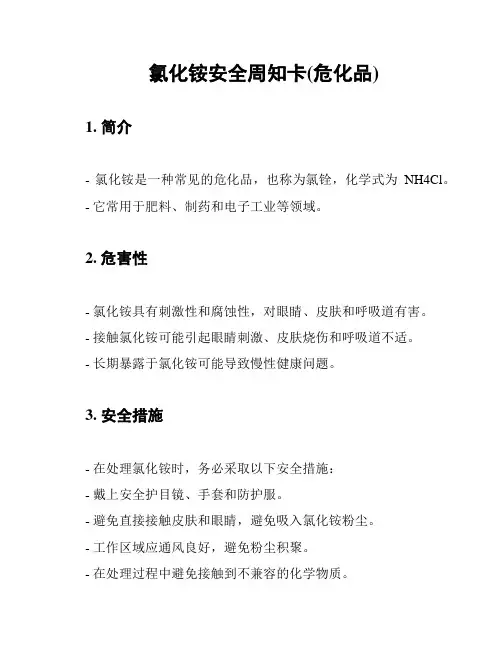
氯化铵安全周知卡(危化品)
1. 简介
- 氯化铵是一种常见的危化品,也称为氯铨,化学式为NH4Cl。
- 它常用于肥料、制药和电子工业等领域。
2. 危害性
- 氯化铵具有刺激性和腐蚀性,对眼睛、皮肤和呼吸道有害。
- 接触氯化铵可能引起眼睛刺激、皮肤烧伤和呼吸道不适。
- 长期暴露于氯化铵可能导致慢性健康问题。
3. 安全措施
- 在处理氯化铵时,务必采取以下安全措施:
- 戴上安全护目镜、手套和防护服。
- 避免直接接触皮肤和眼睛,避免吸入氯化铵粉尘。
- 工作区域应通风良好,避免粉尘积聚。
- 在处理过程中避免接触到不兼容的化学物质。
- 使用合适的储存和运输氯化铵,确保密封性。
4. 应急处理
- 如发生意外事故,迅速采取以下措施:
- 立即离开事故现场,远离火源和热源。
- 如果出现吸入氯化铵粉尘或接触皮肤、眼睛等情况,立即用清水冲洗受影响部位。
- 如有必要,寻求医疗帮助,并提供相关信息。
5. 废物处理
- 处理废弃的氯化铵时,应遵循相关环境法规和安全要求。
- 不得将氯化铵倾倒入下水道或自然环境中。
- 废弃的氯化铵应交由合格的废物处理机构处理。
6. 结论
- 氯化铵是一种危险化学品,使用时必须谨慎。
- 遵循安全措施,避免接触和吸入氯化铵,防范潜在危害。
- 如果出现事故或废物处理需求,及时采取适当的应急和合规措施。
以上是对氯化铵安全周知的简要介绍和指导,希望对大家有所帮助。
如有疑问,请随时咨询相关专业人士。
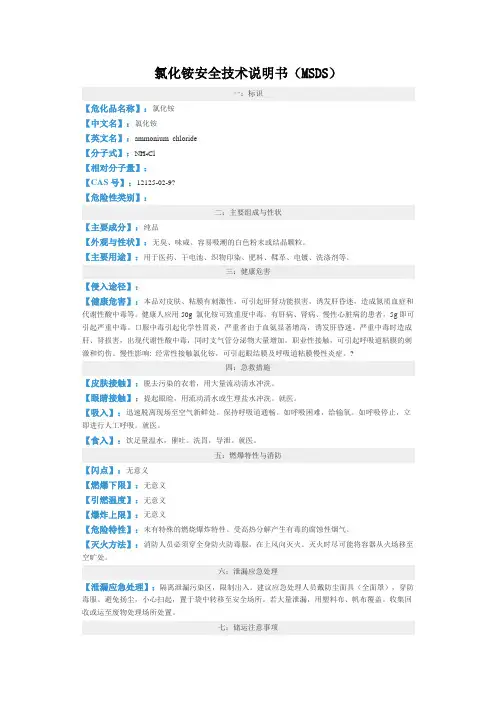
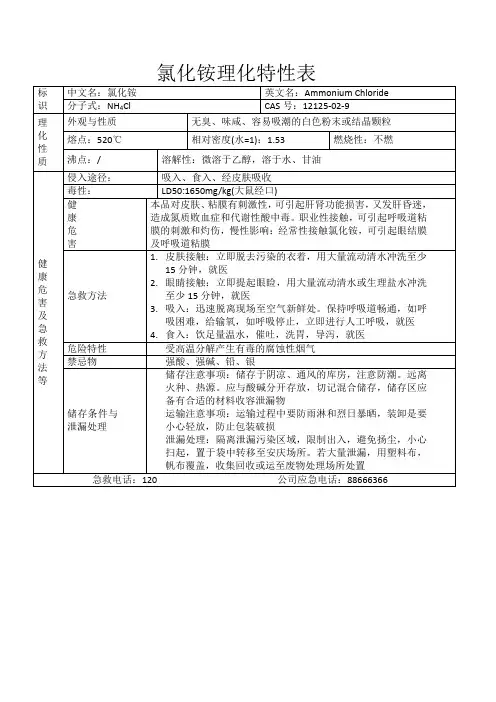

产品简介通用名称:氯化铵英文名称:Ammonium Chloride中文别名:氯化亚、硇砂英文别名:Chlorammonic、Darammon、Expigen、Gen-Diur式量:53.49化学式NH4Cl别名:化学名电盐;电气药粉;盐精物理化学性质:无色立方晶体或白色结晶粉末。
味咸凉而微苦,酸式盐。
相对密度1.527。
易溶于水及乙醇,溶于液氨,不溶于丙酮和乙醚。
加热至100℃时开始显著挥发,337.8℃时离解为氨和氯化氢,遇冷后又重新化合生成颗粒极小的氯化铵而呈白色浓烟,不易下沉,也极不易再溶解于水。
加热至350℃升华,沸点520℃。
吸湿性小,但在潮湿的阴雨天气也能吸潮结块。
水溶液呈弱酸性,加热时酸性增强。
对黑色金属和其它金属有腐蚀性,特别对铜腐蚀更大,对生铁无腐蚀作用。
用途:主要用于干电池、蓄电池、铵盐、鞣革、电镀、医药、照相、电极、粘合剂等。
氯化铵简称“氯铵”,又称卤砂,是一种速效氮素化学肥料,含氮量为24%~25%,属生理酸性肥料。
它适用于小麦、水稻、玉米、油菜等作物,尤其对棉麻类作物有增强纤维韧性和拉力并提高品质之功效。
但是,由于氯化铵的性质决定并如果施用不对路,往往会给土壤和农作物带来一些不良影响。
企业情况:网址:/docc/index.asp大化集团有限责任公司(以下简称大化),始建于1933年,是中国最大、最早的基本化工原料、化学肥料生产基地,是中国石油化工企业100强之一,全集团共有33个分、子公司,其中包括两个中外合资企业,一个B股上市公司。
现有员工7000人,总资产110亿元;年工业总产值20亿元、销售收入34亿元、利税1.3亿元、进出口总额1.2亿美元,其中出口创汇9千万美元。
主导产品以年产30万吨合成氨为核心,形成年产80万吨纯碱、50万吨氯化铵、30万吨复合肥、20万吨硫酸、3万吨浓硝酸、10万吨硝铵、4.5万吨硝盐、22万吨焦炭、90万吨海盐及各种气体的生产能力,有年吞吐能力200万吨的自营码头。
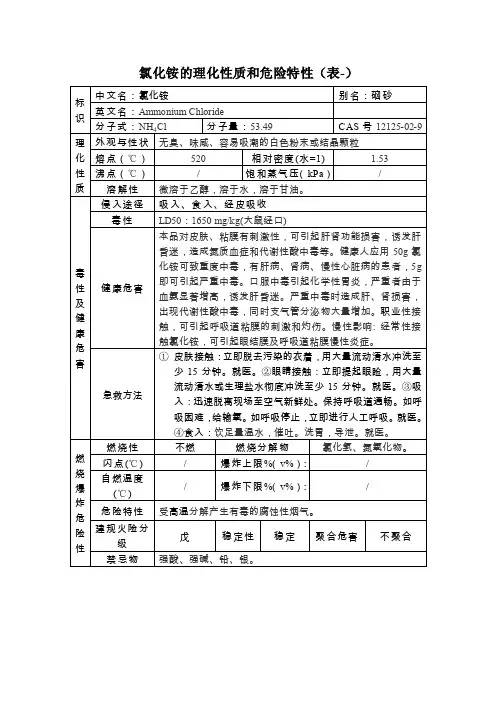
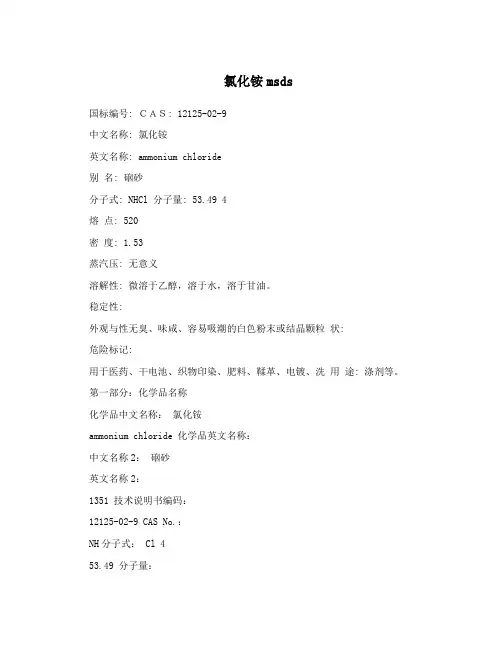
氯化铵msds国标编号: CAS: 12125-02-9中文名称: 氯化铵英文名称: ammonium chloride别名: 硇砂分子式: NHCl 分子量: 53.49 4熔点: 520密度: 1.53蒸汽压: 无意义溶解性: 微溶于乙醇,溶于水,溶于甘油。
稳定性:外观与性无臭、味咸、容易吸潮的白色粉末或结晶颗粒状:危险标记:用于医药、干电池、织物印染、肥料、鞣革、电镀、洗用途: 涤剂等。
第一部分:化学品名称化学品中文名称:氯化铵ammonium chloride 化学品英文名称:中文名称2:硇砂英文名称2:1351 技术说明书编码:12125-02-9 CAS No.:NH分子式: Cl 453.49 分子量:第二部分:成分/组成信息有害物成分含量 CAS No.氯化铵 12125-02-9第三部分:危险性概述危险性类别:侵入途径:健康危害:本品对皮肤、粘膜有刺激性,可引起肝肾功能损害,诱发肝昏迷,造成氮质血症和代谢性酸中毒等。
健康人应用50g 氯化铵可致重度中毒,有肝病、肾病、慢性心脏病的患者,5g即可引起严重中毒。
口服中毒引起化学性胃炎,严重者由于血氨显著增高,诱发肝昏迷。
严重中毒时造成肝、肾损害,出现代谢性酸中毒,同时支气管分泌物大量增加。
职业性接触,可引起呼吸道粘膜的刺激和灼伤。
慢性影响: 经常性接触氯化铵,可引起眼结膜及呼吸道粘膜慢性炎症。
环境危害:燃爆危险:本品不燃,具刺激性。
第四部分:急救措施皮肤接触:脱去污染的衣着,用大量流动清水冲洗。
眼睛接触:提起眼睑,用流动清水或生理盐水冲洗。
就医。
吸入:迅速脱离现场至空气新鲜处。
保持呼吸道通畅。
如呼吸困难,给输氧。
如呼吸停止,立即进行人工呼吸。
就医。
食入:饮足量温水,催吐。
洗胃,导泄。
就医。
第五部分:消防措施危险特性:未有特殊的燃烧爆炸特性。
受高热分解产生有毒的腐蚀性烟气。
有害燃烧产物:氯化氢、氮氧化物。
灭火方法:消防人员必须穿全身防火防毒服,在上风向灭火。
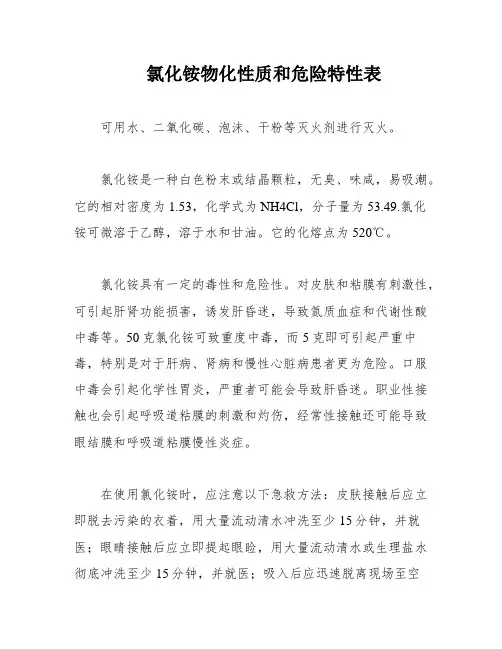
氯化铵物化性质和危险特性表可用水、二氧化碳、泡沫、干粉等灭火剂进行灭火。
氯化铵是一种白色粉末或结晶颗粒,无臭、味咸,易吸潮。
它的相对密度为1.53,化学式为NH4Cl,分子量为53.49.氯化铵可微溶于乙醇,溶于水和甘油。
它的化熔点为520℃。
氯化铵具有一定的毒性和危险性。
对皮肤和粘膜有刺激性,可引起肝肾功能损害,诱发肝昏迷,导致氮质血症和代谢性酸中毒等。
50克氯化铵可致重度中毒,而5克即可引起严重中毒,特别是对于肝病、肾病和慢性心脏病患者更为危险。
口服中毒会引起化学性胃炎,严重者可能会导致肝昏迷。
职业性接触也会引起呼吸道粘膜的刺激和灼伤,经常性接触还可能导致眼结膜和呼吸道粘膜慢性炎症。
在使用氯化铵时,应注意以下急救方法:皮肤接触后应立即脱去污染的衣着,用大量流动清水冲洗至少15分钟,并就医;眼睛接触后应立即提起眼睑,用大量流动清水或生理盐水彻底冲洗至少15分钟,并就医;吸入后应迅速脱离现场至空气新鲜处,保持呼吸道通畅,如呼吸困难,给输氧,如呼吸停止,立即进行人工呼吸,并就医;食入后应饮足量温水,催吐,洗胃,导泄,并就医。
氯化铵是一种不易燃的物质,但在高温下会分解产生有毒的腐蚀性烟气。
它与强酸、强碱、铅和银不宜混储。
在储存和运输时,应储存在阴凉、通风的库房中,远离火源和热源,防止潮湿,切忌与酸碱混储。
在泄漏处理时,应隔离泄漏污染区,限制出入,并戴防尘面具和穿防酸碱工作服,避免扬尘,小心扫起,置于袋中转移至安全场所。
对于大量泄漏,应用塑料布、帆布覆盖,收集回收或运至废物处理场所处置。
灭火时可使用水、二氧化碳、泡沫、干粉等灭火剂。
开,以防爆炸,同时保持足够的安全距离。
在灭火过程中,应该注意防止火势扩大,确保自身安全。
为了保证灭火效果,消防人员需要进行专业的训练和实践。
在火灾现场,消防人员需要迅速判断火势大小和火源位置,采取适当的灭火措施。
同时,消防人员也需要与其他救援人员进行协作,确保灭火工作的顺利进行。
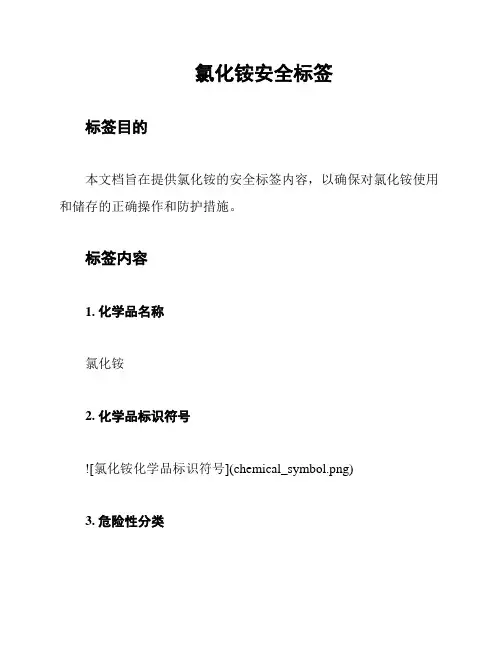
氯化铵安全标签标签目的本文档旨在提供氯化铵的安全标签内容,以确保对氯化铵使用和储存的正确操作和防护措施。
标签内容1. 化学品名称氯化铵2. 化学品标识符号3. 危险性分类按照国际标准化组织(ISO)的危险性分类,氯化铵被归类为以下危险性:- 刺激性:可以对皮肤、眼睛和呼吸系统产生刺激作用。
4. 危险的成分氯化铵(化学式:NH4Cl)5. 安全操作指南- 使用个人防护装备(如手套、护目镜和防护口罩)。
- 在使用和操作氯化铵时,请确保通风良好。
- 避免直接接触皮肤和眼睛。
- 在使用氯化铵之前,请阅读并遵循相关的操作和处理手册。
6. 紧急处理措施- 如果发生皮肤接触,请立即用水冲洗受影响部位。
- 如果发生眼睛接触,请立即用大量清水冲洗眼睛至少15分钟,并寻求医疗帮助。
- 如果氯化铵被误吞咽,请立即喝大量水,并尽快就医。
7. 储存要求- 将氯化铵存放在干燥、通风良好的地方。
- 避免与易燃物质、氧化剂和酸性物质接触。
- 保持包装完好,远离儿童和宠物。
其他注意事项本安全标签仅提供了关于氯化铵的基本安全信息。
在使用氯化铵之前,请详细阅读供应商提供的安全资料表,并遵循所有相关的安全建议和操作指南。
注意:本文档提供的信息仅供参考,并不代表法律或专业咨询。
在使用氯化铵或做出任何决策之前,请咨询合适的专业人士以获得准确的建议和指导。
本文档提供的信息仅供参考,并不代表法律或专业咨询。
在使用氯化铵或做出任何决策之前,请咨询合适的专业人士以获得准确的建议和指导。
氯化铵 MSDS1. 产品识别- 中文名: 氯化铵- 英文名: Ammonium chloride- 化学式: NH4Cl2. 成分/组成信息- 主要成分: 氯化铵(NH4Cl)- 其他成分: 无3. 危险性概述- 对眼睛和呼吸系统有刺激性,可能导致眼和呼吸道刺激。
- 长期或重复接触可能导致皮肤干燥或龟裂。
4. 急救措施- 吸入: 将受害人移至新鲜空气中,如有呼吸困难,立即就医。
- 眼部接触: 立即用大量清水冲洗眼睛至少15分钟,同时取下隐形眼镜(若佩戴有)。
- 皮肤接触: 立即用大量水和温和肥皂清洗受影响的区域。
- 吞咽: 给受害人提供大量水,不要催吐,立即就医。
5. 泄漏应急处理- 防止泄漏物进入下水道、排水管或环境中。
- 尽量用干净的工具收集泄漏物,避免产生尘埃。
- 将泄漏物装入适当的中,标注内容并妥善处理。
6. 操作处置- 避免吸入粉尘,避免接触皮肤和眼睛。
- 在操作过程中要穿戴适当的防护设备,如防护手套、护目镜和口罩。
7. 储存和运输- 储存在干燥、清洁、密闭的中,远离明火和高温。
- 避免与强酸、强碱等物质接触。
- 车辆运输时应避免剧烈震动,防止包装破裂泄漏。
8. 毒理学信息- 急性口服毒性: 高剂量可能引起胃肠道刺激症状。
- 急性皮肤刺激性: 会引起皮肤干燥或龟裂。
- 急性眼刺激性: 接触眼睛可能导致眼部刺激。
- 慢性毒性: 没有相关数据。
以上是氯化铵的主要信息,请在使用这种化学物质时遵循安全操作规程,并根据需要进行防护措施。
氯化铵化学品安全技术说明书 (MSDS)产品概述* 氯化铵是一种常见的化学品,具有广泛的应用领域。
本文档旨在提供有关氯化铵的安全技术信息和操作指南。
物理性质* 外观:白色结晶固体* 溶解度:易溶于水* 分子量:XX g/mol* 熔点:XX°C* 沸点:XX°C健康和安全信息* 接触:避免直接皮肤接触,如接触发生,立即用清水冲洗。
* 吸入:在操作和处理氯化铵时避免吸入粉尘或蒸气。
确保操作场所通风良好。
* 摄入:不得食用或饮用氯化铵。
如意外摄入,立即寻求医疗协助。
灭火措施* 如发生氯化铵火灾,使用适当的灭火剂进行灭火,如二氧化碳、泡沫或干粉。
泄漏处理* 小规模泄漏:尽量阻止泄漏物扩散,并用干净的工具收集。
将废料妥善处理。
* 大规模泄漏:立即通知有关部门,采取适当的安全措施并进行专业处理。
储存和处理* 存放在干燥、通风良好的地方,远离明火、热源和易燃物品。
* 避免与氧化剂、酸类和可燃物混合存储。
* 使用个人防护装备,如化学手套、防护眼镜和防护服。
应急措施* 如发生事故或不适,立即停止操作并寻求医疗援助。
* 保持急救设备和紧急联系电话的可靠性。
处理废弃物* 废弃物应按照当地法规进行分类、封存和处理。
* 请咨询专业机构以获取正确的废弃物处理指南。
其他注意事项* 仅限专业人员操作和使用。
* 在使用前请阅读和理解本安全技术说明书。
* 遵守当地法规和安全操作规程。
以上所述仅为简要介绍,详细信息请参阅完整的氯化铵化学品安全技术说明书。
注:此文档仅供参考,请勿引用或证实任何内容。
氯化铵MSDS
1. 化学品基本信息
- 化学品名称:氯化铵
- 化学式:NH4Cl
- 分子量:53.49 g/mol
- CAS号:-02-9
- 外观:白色结晶
- 溶解性:易溶于水和酒精,微溶于醚
2. 危险性评估
2.1 急性毒性
- 经口毒性:LD50 (大鼠,经口)为1650 mg/kg。
口服过量可能导致恶心、呕吐和胃痛。
2.2 刺激性
- 皮肤刺激:可能导致轻度皮肤刺激,如红肿和瘙痒。
- 眼睛刺激:可能导致眼睛刺激,如疼痛和红肿。
2.3 致敏性
- 无致敏性信息。
2.4 环境影响
- 氯化铵可能对水生生物有毒,并对水质造成污染。
3. 应急措施
- 皮肤接触:立即用大量清水冲洗,必要时就医。
- 眼睛接触:立即用大量清水冲洗眼睛,至少持续15分钟;如果佩戴隐形眼镜,先取下。
就医。
- 吸入:迅速将受害人转移到空气清新的地方。
如出现呼吸困难,给予人工呼吸或氧气。
就医。
- 吞食:如果意识清醒,漱口,不要催吐。
就医。
4. 防护措施
- 呼吸系统防护:接触到大量粉尘时,佩戴防尘口罩。
- 眼睛防护:佩戴化学安全护目镜。
- 皮肤防护:穿戴耐酸碱防护服。
- 其他防护措施:工作现场保持清洁,定期洗手,避免吸入粉尘。
5. 废弃处置
- 废弃物处理:按照当地法规进行处理,并遵守相关规定。
以上是关于氯化铵的MSDS(安全数据表)。
请在使用或处理该化学品时,务必遵守相关的安全操作规程和法规要求,以确保人员和环境的安全。
一、 理化特性:
二、 危险性概述:
1、 危险性类别:对皮肤、粘膜有刺激性
2、 G HS-分类:急性毒性, 经口(类别4);眼睛刺激(类别2A);急性水
生毒性(类别2)。
3、 图标或危害标志
警示词:警告
4、 危险信息:本品对皮肤、粘膜有刺激性,可引起肝肾功能损害,诱
发肝昏迷,造成氮质血症和代谢性酸中毒等。
吞咽有害。
造成严重眼刺激。
对水生生物有毒。
5、预防措施:不要吸入粉尘/烟/气体/烟雾/蒸气/喷雾。
作业后彻底清
洗。
戴防护手套/穿防护服/戴防护眼罩/戴防护面具。
使用本产品
时不要进食、饮水或吸烟。
避免释放到环境中。
三、急救措施
1、皮肤接触:脱去污染的衣着,用大量流动清水冲洗。
2、眼睛接触:提起眼睑,用流动清水或生理盐水冲洗。
就医。
3、吸入:迅速脱离现场至空气新鲜处。
保持呼吸道通畅。
如呼吸困难,给输氧。
如呼吸停止,立即进行人工呼吸。
就医。
4、食入:饮足量温水,催吐。
洗胃,导泄。
就医。
四、消防措施
1、危险特性:未有特殊的燃烧爆炸特性。
受高温分解产生有毒的腐蚀性烟气。
2、灭火方法与灭火剂:消防人员必须穿全身防火防毒服,在上风向灭火。
灭火时尽可能将容器从火场移至空旷处。
失火时,可用水、沙土、二氧化碳灭火器扑救。
3、灭火注意事项及措施:无资料。
五、泄漏应急措施
1、作业人员防护措施:使用个人防护装备。
避免粉尘生成。
避免吸入蒸气、气雾或气体。
保证充分的通风。
避免吸入粉尘。
2、泄漏化学品的收容、清除方法及处置材料:应急处理:隔离泄漏污染区,限制出入。
建议应急处理人员戴防尘面具(全面罩),穿防毒服。
避免扬尘,小心扫起,置于袋中转移至安全场所。
若大量泄漏,用塑料布、帆布覆盖。
收集回收或运至废物处理场所处置。
六、操作处置与储存
1、操作注意事项:密闭操作,全面排风。
操作人员必须经过专门培训,严格遵守操作规程。
建议操作人员佩戴自吸过滤式防尘口罩,戴化学安全防护眼镜,穿防毒物渗透工作服,戴橡胶手套。
避免产生粉尘。
避免与酸类、碱类接触。
搬运时轻装轻卸,防止包装破损。
配备泄漏应急处理设备。
倒空的容器可能残留有害物。
2、储存注意事项:储存于阴凉、通风的库房。
远离火种、热源。
应与酸类、碱类等分开存放,切忌混储。
储区应备有合适的材料收容泄漏物。
七、个体防护
1、呼吸系统防护:空气中粉尘浓度超标时,必须佩戴自吸过滤式防尘口罩。
紧急事态抢救或撤离时,应该佩戴空气呼吸器。
2、眼睛防护:戴化学安全防护眼镜。
3、皮肤和身体防护:穿防毒物渗透工作服。
4、手防护:戴橡胶手套。
七、稳定性和反应性
1、稳定性:无资料
2、不相容的物质:强酸、强碱、强氧化剂、铅、银。
3、应避免的条件:暴露于湿气可能影响产品质量。
4、危险反应:燃烧产物氯化氢、氮氧化物有害。
八、废弃处置
1、废弃处置方法:用氢氧化钠溶液预处理,放出的氨气回收使用,剩
下的处理液加水稀释到规定的容许浓度,再排入废水系统。
九、运输信息
1、包装方法
应储存在阴凉、通风、干燥的库房内,注意防潮。
2、运输注意事项
避免与酸类、碱类物质共储混运。
运输过程中要确保容器不泄漏、不倒塌、不坠落、不损坏。
运输途中应防曝晒、雨淋,防高温。
车辆运输完毕应进行彻底清扫。